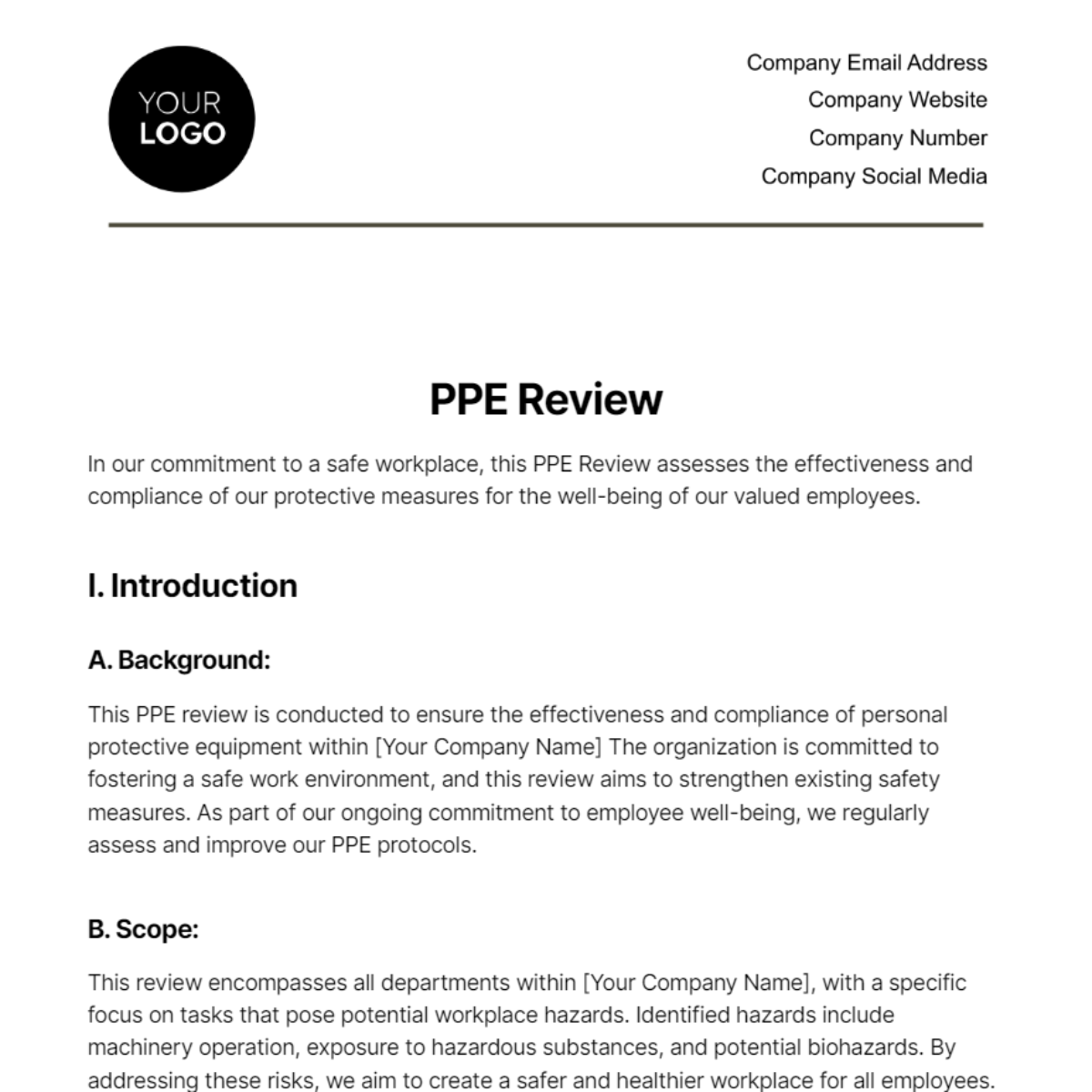Free PPE Review

In our commitment to a safe workplace, this PPE Review assesses the effectiveness and compliance of our protective measures for the well-being of our valued employees.
I. Introduction
A. Background:
This PPE review is conducted to ensure the effectiveness and compliance of personal protective equipment within [Your Company Name] The organization is committed to fostering a safe work environment, and this review aims to strengthen existing safety measures. As part of our ongoing commitment to employee well-being, we regularly assess and improve our PPE protocols.
B. Scope:
This review encompasses all departments within [Your Company Name], with a specific focus on tasks that pose potential workplace hazards. Identified hazards include machinery operation, exposure to hazardous substances, and potential biohazards. By addressing these risks, we aim to create a safer and healthier workplace for all employees.
II. Risk Assessment
A. Identification of Hazards:
Hazard Category | Specific Hazards |
Physical | Machinery, Falling Objects, etc. |
Chemical | Hazardous Substances, Gases, etc. |
Biological | Biohazards, Contaminants, etc. |
B. Risk Analysis
Task/Activity | Likelihood (1-5) | Severity (1-5) | Risk Level (Likelihood x Severity) |
Machine Operation | 4 | 3 | 12 |
Chemical Handling | 2 | 5 | 10 |
Laboratory Work | 3 | 4 | 12 |
III. Regulatory Compliance
The PPE program at [Your Company Name] aligns with and exceeds relevant safety standards and regulations, including OSHA regulations and ANSI standards.
IV. Current PPE Inventory
A. Documentation:
PPE Type | Quantity in Stock | Condition |
Hard Hats | 50 | Good |
Safety Glasses | 100 | Some scratched lenses |
Respirators | 20 | Filters need replacement |
B. Usage Analysis:
1. The existing PPE effectively mitigates identified risks.
2. Recommendation: Replace scratched lenses on safety glasses to maintain optimal vision protection.
V. PPE Selection
A. Task-specific Analysis:
1. Head Protection: Hard Hats are mandatory for employees engaged in machinery operation and construction tasks.
2. Eye and Face Protection: Safety Glasses are required for tasks involving potential eye hazards.
3. Hand Protection: Chemical-resistant Gloves provided for employees handling hazardous substances.
B. Types of PPE:
PPE Type | Designated Uses |
Hard Hats | Machinery operation, Construction, Falling Object Protection |
Safety Glasses | Eye protection for machine operation, Welding, Chemical handling |
Face Shields | Additional protection for tasks with airborne particles |
Chemical-resistant Gloves | Protection during handling of hazardous substances |
Respirators | Protection against airborne contaminants and particulate matter |
High-Visibility Clothing | Enhanced visibility in low-light conditions, such as construction sites |
VI. Training and Education
A. Employee Training:
1. All employees have undergone comprehensive PPE training during onboarding.
2. Regular refreshers on proper usage and maintenance to ensure ongoing compliance.
B. Demonstration and Practice:
1. Hands-on sessions conducted regularly for correct PPE donning and doffing, emphasizing task-specific requirements.
VII. Maintenance and Inspection
A. Monthly inspections of PPE by designated safety officers.
B. Replacement of damaged or worn-out items promptly.
C. Detailed records of inspections and maintenance activities maintained for audit purposes.
VIII. Emergency Response Planning
A. PPE is seamlessly integrated into emergency response plans.
B. Special considerations for evacuation and first aid to ensure PPE remains effective in crisis situations.
IX. Communication and Feedback
A. Open channels established for employees to report PPE issues, fostering a proactive safety culture.
B. Regular safety meetings provide a platform for discussing and addressing employee concerns.
C. Regular reviews and updates of the PPE program based on employee feedback and emerging safety trends.
X. Review Schedule
A. Annual PPE reviews scheduled to coincide with broader safety assessments.
B. Unscheduled reviews triggered by significant changes in work processes or incidents.
XI. Conclusion
A. Summary of Findings:
The current PPE program at [Your Company Name] demonstrates effectiveness in mitigating identified hazards. Rigorous risk assessments, coupled with task-specific PPE selection and regular maintenance, contribute to a safe work environment.
B. Action Steps:
In response to this review, immediate action includes replacing scratched lenses on safety glasses. Ongoing initiatives focus on reinforcing employee awareness through regular safety campaigns and conducting periodic refresher training sessions. These measures ensure continuous adherence to safety protocols and foster a proactive safety culture within the organization.
- 100% Customizable, free editor
- Access 1 Million+ Templates, photo’s & graphics
- Download or share as a template
- Click and replace photos, graphics, text, backgrounds
- Resize, crop, AI write & more
- Access advanced editor
Unveil safety excellence with our PPE Review Template on Template.net. This editable and customizable solution enables assessment and enhancement of your Personal Protective Equipment program. Ensure regulatory compliance, conduct comprehensive risk assessments, and nurture a proactive safety culture. Effortlessly elevate workplace safety with a template tailored to your organization's unique needs.





























